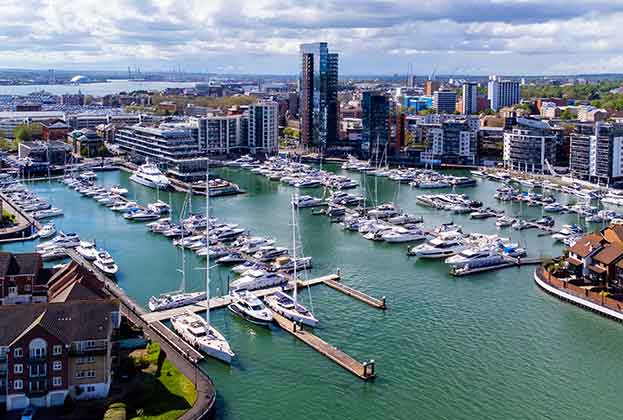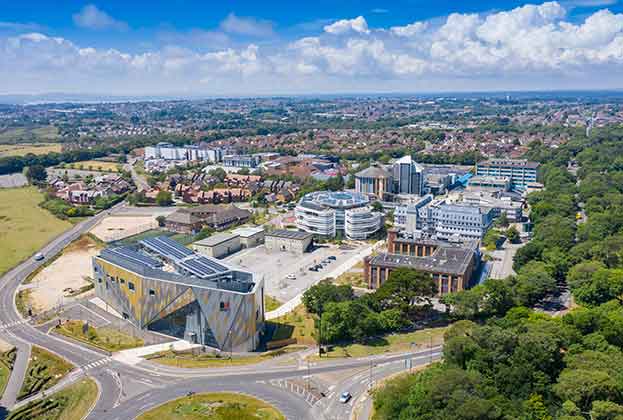What are the catalysts to achieving large-scale growth and innovation in the region? What are the barriers and constraints to overcome?
The Central South is well-placed to deliver growth. It can do this by focusing on its existing core strengths, including its strong maritime economy, six universities with linked science and innovation parks such as the Southampton Science Park, the relative affordability of housing in the Central South in comparison to the wider South East alongside its attractive coastal offer. But in order to succeed, there are clear barriers to overcome to accelerate growth.
Better planning for employment and improvements to infrastructure, facilitating greater connectivity across the Central South, will support existing businesses but also attract new commercial occupiers and inward investment. As a result, an enhanced business offering will create more high-value job opportunities to attract and retain talent in the region.
Building more homes in the right places, across a range of price points and a diverse range of tenures is also key to unlocking growth and supporting the retention of a highly skilled workforce for the long term.
Strategic planning to deliver a more joined-up approach to growth across the Central South is fundamental in order to overcome land and planning constraints currently preventing new supply from coming forward.
Physical land constraints
With the English Channel and the Solent to the south and other planning constraints such as the Green Belt and national parks, there is a scarcity of available land for new housing and employment across the Central South. This makes it even harder to bring forward deliverable sites through planning, particularly at a time when planning consents are falling due to a lack of clarity at the national level.
The Dorset Heathlands are a further constraint on housing growth due to the restrictions on development within 400 metres of heathland areas.
Nutrient neutrality is a further major planning constraint which has been significantly constraining new development across the region.
As of August 2023, there were 55 sites with a full application submitted but remain undetermined across the Solent in nutrient neutrality catchment areas, with a total combined capacity to deliver 6,982 homes. For sites with full permission granted, this was slightly lower, with 2,631 homes spread across 29 sites, according to data from Glenigan.
There is increasing evidence of mitigation schemes that have been used by some local authorities in the region to unlock development, indicating progress towards overcoming this major development constraint in the region.
Fail to plan, plan to fail?
Plan-making, or lack of, is equally a major constraint in the region, resulting in reduced levels of housing delivery across the Central South. Local Plans are largely out of date, with Portsmouth’s dating back to 2012 and Southampton back to 2010. Both face a presumption in favour of development due to failing their Housing Delivery Test with new plans a long way off from being adopted.
In Bournemouth, Christchurch and Poole, where the three local authorities combined to form a single unitary authority in 2019, a joint Local Plan has stalled with the council announcing a two-year delay due to lack of clarity from central government around housing targets and Green Belt release.
A failure to adopt Local Plans across the region and plan for future housing requirements at both a local level and a more joined-up strategic level poses a significant risk to future economic growth in the Central South. A lack of housing supply across a variety of price points and tenures, in particular in the urban centres or within a reasonable commuting distance, makes the region less attractive to both employees and commercial occupiers.
However, Southampton is leading the way in its plans for future evolution of the city through the creation of a Southampton Renaissance Board made up of key city stakeholders, including local institutions, landowners and businesses. This will be allied to the development of the Renaissance Masterplan setting out a clear vision for the future growth of the city over the coming decades.
How well-connected is existing housing to employment?
The development pipeline needs to be well integrated and connected to the local economy, aligning the delivery of new homes with future economic growth across the Central South. Whilst some jobs are located in ‘out of town’ employment hubs and business parks, the majority are located in the ‘city core’. Beyond the urban centres, there is a gap in public transport provision, with a heavy reliance on car transport in order to access these key employment clusters.
The urban centres of the Central South have sizeable development pipelines, particularly Portsmouth. There are 5,000 homes located in each city’s development pipeline that are accessible within 15 minutes by public transport. This increases substantially by car (within a 45-minute drive), to 16,000 in Bournemouth, 39,000 in Southampton and 48,000 in Portsmouth.
Portsmouth is on track to develop a major marine employment hub at Tipner through City Deal funding that will help secure the marine sector’s importance to the UK’s economy focussed on the Solent’s Centre of Excellence
Councillor Steve Pitt, Leader of Portsmouth City Council
The potential size of the employment markets also follows the same pattern as the development pipeline, with a much greater number of people able to access Portsmouth city centre than Southampton and BCP. The latter does have a greater proportion of higher-value jobs within the conurbation and accessible within 15 minutes of public transport.
In order to achieve more sustainable forms of development and to increase the size of the employment markets, public transport infrastructure improvements have a key role to play in order to make more jobs accessible to more people and to unlock more sites with capacity to deliver housing.
A climate emergency
In recent years, all three councils have declared climate emergencies and have set targets to meet net zero requirements. Portsmouth City Council declared a ‘climate emergency’ in 2019 with an objective to be carbon neutral by 2030. BCP and Southampton later followed the same year with targets to achieve carbon neutrality by 2030 and 2040, respectively.
A constraint on achieving this lies in the age and inefficiency of existing housing stock. This is particularly pertinent in Portsmouth, which has one of the densest and oldest housing stock in the region. Nearly half of its homes were built before 1929 with an average EPC rating of D, compared to just 22% across the South East.
If the Central South were able to attract more employers, this would retain more skilled talent and graduates in the region, potentially living in sustainable city centre locations, kickstarting the regeneration of the urban centres. If the region was able to retain more skilled talent and graduates, as a result, this would encourage more employers to relocate to the Central South and subsequently attract more residents, therefore kickstarting the regeneration of the city centres.
Connecting to the grid
The expected growth in population and economic activity in the Central South, alongside net zero aspirations, means there is increasing pressure on the electrical grid. The ability to build enough infrastructure to facilitate these growing requirements is hindered by government policy, regulation, skills gaps and local objection. This is resulting in developments across the UK now struggling to secure power connections in a cost-effective or timely manner.
Without the ability in the short term to build infrastructure at scale, innovative solutions are needed. This includes using data-driven energy calculations to better understand initial power requirements, improved scheduling and planning of needs over time, and utilising smart grid and local generation technologies to alleviate these problems at a local level.
Read the articles within Central South: unlocking capacity for growth – Q1 2024 below.
.jpg)

